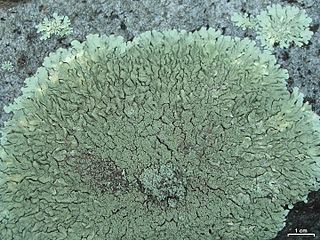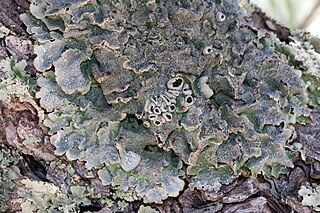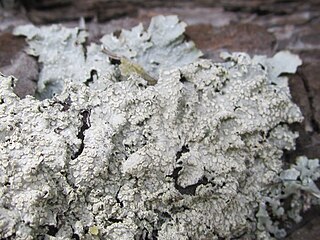
Pseudevernia is a genus of foliose lichens in the family Parmeliaceae. The type species of the genus, Pseudevernia furfuracea, has substantial commercial value in the perfume industry.

Myelochroa is a genus of foliose lichens in the family Parmeliaceae. They are commonly known as axil-bristle lichens. It was created in 1987 to contain species formerly placed in genus Parmelina that had a yellow-orange medulla due to the presence of secalonic acids. Characteristics of the genus include tightly attached thalli with narrow lobes, cilia on the axils, and a rhizinate black lower surface. Chemical characteristics are the production of zeorin and related triterpenoids in the medulla. Myelochroa contains about 30 species, most of which grow on bark. The genus has centres of distribution in Asia and North America.

Melanohalea is a genus of foliose lichens in the family Parmeliaceae. It contains 30 mostly Northern Hemisphere species that grow on bark or on wood. The genus is characterised by the presence of pseudocyphellae, usually on warts or on the tips of isidia, a non-pored epicortex and a medulla containing depsidones or lacking secondary metabolites. Melanohalea was circumscribed in 2004 as a segregate of the morphologically similar genus Melanelia, which was created in 1978 for certain brown Parmelia species. The methods used to estimate the evolutionary history of Melanohalea suggest that its diversification primarily occurred during the Miocene and Pliocene epochs.

Cetrelia is a genus of leafy lichens in the large family Parmeliaceae. They are commonly known as sea-storm lichens, alluding to the wavy appearance of their lobes. The name of the genus, circumscribed in 1968 by the husband and wife lichenologists William and Chicita Culberson, alludes to the former placement of these species in the genera Cetraria and Parmelia.

Punctelia is a genus of foliose lichens belonging to the large family Parmeliaceae. The genus, which contains about 50 species, was segregated from genus Parmelia in 1982. Characteristics that define Punctelia include the presence of hook-like to thread-like conidia, simple rhizines, and point-like pseudocyphellae. It is this last feature that is alluded to in the vernacular names speckled shield lichens or speckleback lichens.

Xanthoparmelia is a genus of foliose lichens in the family Parmeliaceae. This genus of lichen is commonly found in the United States, South America, southern Africa, Europe, Australia, and New Zealand.

Esslingeriana is a fungal genus in the family Parmeliaceae. The genus is monotypic, containing the single foliose lichen species Esslingeriana idahoensis, commonly known as the tinted rag lichen. It is found in northwestern North America.
Bulbothrix meizospora is a species of foliose lichen in the family Parmeliaceae. It is found in Africa, Asia, and South America, where it grows on tree bark.

Punctelia rudecta, commonly known as the rough speckled shield or the speckleback lichen, is a North American species of foliose lichen in the family Parmeliaceae. This species can be readily identified by the light color of the thallus underside, the relatively large lobes at the edges of the thallus, and the tiny white pores present on the top of the thallus that are characteristic of the genus Punctelia. The lichen is quite abundant and widespread in the eastern and southeastern United States, and is less common in Canada and Mexico. The lichen usually grows on bark, and less commonly on shaded rocks. There are several lookalike Punctelia species; these can often be distinguished from P. rudecta by differences in distribution or in the nature of the reproductive structures present on the thallus.
Xanthoparmelia serusiauxii is a species of foliose lichen in the family Parmeliaceae. Found in Namibia, it was formally described as a new species in 1986 by American lichenologist Mason Hale. The type specimen was collected by Hale from the Laguneberg Mountains, southeast of Cape Cross. There, it is common on dolerite boulders and small, flat pebbles. The specific epithet honours Emmanuël Sérusiaux, who, according to Hale, "was the first lichenologist to collect this unusual lichen in Namibia".

Punctelia caseana is a species of foliose lichen in the family Parmeliaceae. Its range covers eastern North America, extending south to central and northern Mexico, where it grows on the bark of many species of hardwood and conifer trees.
Punctelia cedrosensis is a species of foliose lichen in the family Parmeliaceae. It is endemic to Mexico, where it grows on the bark of conifers.

Punctelia punctilla is a species of foliose lichen in the family Parmeliaceae. It is found in Africa, South America, and North America, where it grows on bark and on rocks. The main characteristics that distinguish Punctelia punctilla from other species of Punctelia are the presence of isidia on the thallus surface, a pale brown thallus undersurface, and the presence of lecanoric acid in the medulla.

Punctelia hypoleucites, commonly known as the southwestern speckled shield lichen, is a species of foliose (leafy) lichen in the family Parmeliaceae. First formally described by Finnish botanist William Nylander as a species of Parmelia, it was transferred to the genus Punctelia in 1982. The lichen is found in Africa, North America, and South America, where it grows on the bark of both hardwood and coniferous trees. Its greenish-grey thallus is covered with tiny white pseudocyphellae – minute holes in the thallus surface that facilitate gas exchange. Some macroscopic features that help distinguish this species from other related members of the genus include the presence and the structure of the apothecia, the absence of asexual surface propagules, and the light brown color of the thallus undersurface. Chemically, the presence of lecanoric acid in the medulla and atranorin in the cortex help distinguish it from lookalikes.

Punctelia bolliana, the eastern speckled shield lichen, is a species of foliose lichen in the family Parmeliaceae. It is found in North America, with a distribution extending from the Canadian province of Ontario south to the central and northeastern United States and Mexico. It grows on the bark of both deciduous trees and coniferous trees. The combination of characteristics that distinguishes this species from others in genus Punctelia are the absence of the vegetative propagules isidia and soralia, a pale brown lower thallus surface, and the presence of the secondary chemical protolichesterinic acid in the medulla.

Punctelia perreticulata is a widely distributed species of foliose lichen in the family Parmeliaceae. It occurs in Mediterranean Europe and Russia, North America, South America, Australia, and New Zealand, where it grows on rocks, bark, or wood. Its main distinguishing features are its thallus surface, marked with many shallow depressions, grooves, or pits, and sorediate pseudocyphellae. The lower side of the thallus is ivory to tan towards the centre and the major secondary metabolite in the medulla is lecanoric acid. A lookalike species with which it has been historically confused is Punctelia subrudecta; this lichen can be distinguished from Punctelia perreticulata by the texture of the thallus surface, or, more reliably, by the length of its conidia.

Punctelia graminicola is a species of foliose (leafy) lichen in the family Parmeliaceae. It grows on rocks, and, less frequently, on bark in North America, South America, and East Africa. It has a blue-grey thallus measuring up to about 15 cm (6 in), covered with tiny pores called pseudocyphellae. Sometimes the lichen forms small lobes that project out from the surface. Fruiting bodies are uncommon in this species; if present, they resemble small cups with a brown internal disc measuring 3–10 mm (0.1–0.4 in) in diameter. A lookalike species, Punctelia hypoleucites, is not readily distinguishable from Punctelia graminicola by appearance or habitat alone; these species can only be reliably differentiated by examining the length of their conidia.
Xanthoparmelia joranadia is a lichen which belongs to the Xanthoparmelia genus. The lichen is rare and is listed as imperiled by the Nature Conservatory. It is noted for being similar to Xanthoparmelia arida and Xanthoparmelia lecanorica.
Bulbothrix klementii is a species of corticolous (bark-dwelling), foliose lichen in the family Parmeliaceae. Originally found in Venezuela, it has since been recorded in Australia and Brazil.

Hypotrachyna catawbiensis, the powder-tipped antler lichen, is a species of foliose lichen in the family Parmeliaceae. First described in 1941, it forms pale ivory to greenish-gray leaf-like growths that attach loosely to tree bark or rocks. The lichen has narrow, forking lobes that often curl inward, and produces powdery structures called soredia for asexual reproduction. Though originally discovered in the Appalachian Mountains of the eastern United States, it has since been found across tropical and temperate regions worldwide, including Mexico, South America, East Africa, China, and Papua New Guinea. It usually grows at high elevations. Genetic studies have shown that despite this widely scattered distribution, populations from different continents belong to the same species. It typically grows as an epiphyte on hardwood trees, though it can also be found on conifers and rocks.















